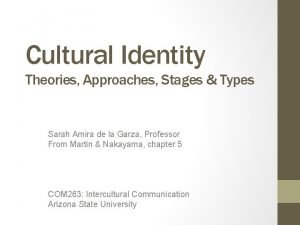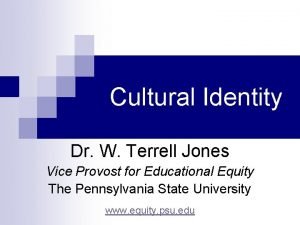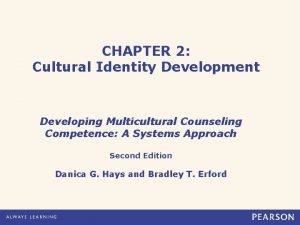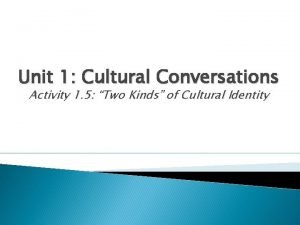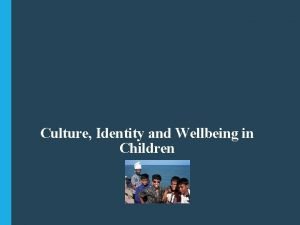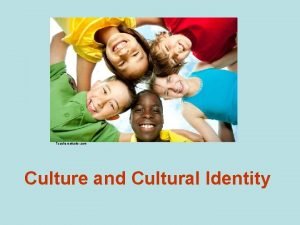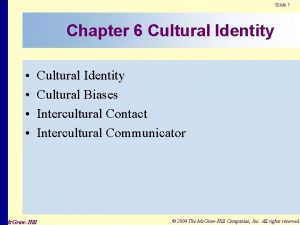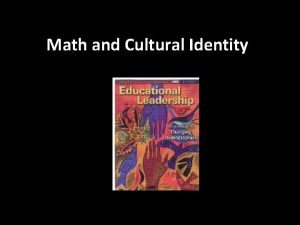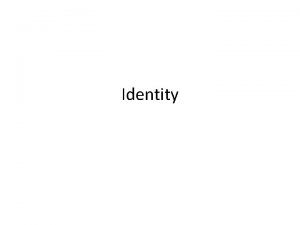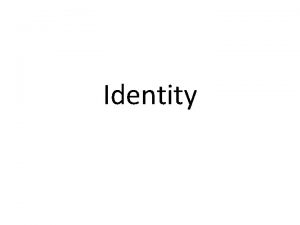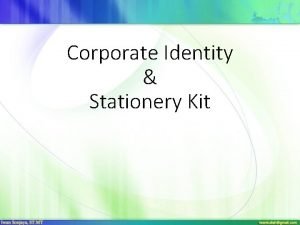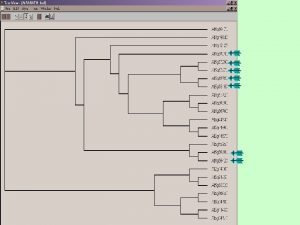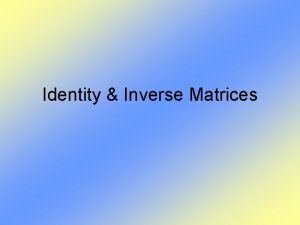Chapter 6 Language Cultural Identity Cultural Identity The













- Slides: 13

Chapter 6 Language & Cultural Identity

Cultural Identity • The association of language with a person’s sense of self. • A natural connection between language spoken by members of a social group & that group’s identity (by accent- voc- discourse patterns) / speakers identified as members • Membership to a social/discourse comm. Draws: – Strength & pride – Social importance – Historical continuity

How do we define which group one belongs to? – In isolated homogeneous communities, Members are: who share common cultural practices and daily faceto-face interactions. – Difficult to define boundaries in modern open mixed societies / Clip # 28 – E. g. Old (Trobrianders) tribes vs. modern open societies • 1/ Group Identity: • Group identities based on race Not easy to define: – Many genetic differences • E. g. between members of the same White/Black race

• 2/ Regional identity • equally difficult to define • E. g. population of France/ “a multinational state. . It is one nation, the product of a long history” • 3/ National Identity: – Never clear-cut/ citizenship – E. g. Turkish passport vs. Turkish national identity

One language = one culture – (not always true) – Individuals assume several collective identities/ are likely to change over time. - e. g. Immigrants (Turkish)/ ‘long distance nationalism’/ sense of self linked to country of origin- political views…/ nostalgia ‘old country’/’long distance nationalism’/ language differs/ ‘imagined community’

Cultural Stereotypes • Our perception of someone’s social identity is culturally determined. • Diffusion: – Stereotypes are formed by extending the characteristics of one person (or group. . ) To all. – E. g. Ø ‘All Americans are individualists’ Ø ‘All Chinese look alike. ’ v Clip # 29

Examples • 1. When one’s impression is focused by the classificatory concepts prevalent in his society – E. g. The official Singaporean ethnic categories: Chinese, Malay, Indian

• 2. Societies impose racial & ethnic categories only on certain groups. – E. g. Danish women vs. African-American boy/ he used ‘race’ to identify his cultural identity but they depended on language. • 3. The complex language- cultural identity relationship – E. g. Chinese speak languages/ dialects that are mutually not understood but still identify themselves all as ethnically Chinese.

Language Crossing as Act of Identity • One way of surviving culturally in immigration settings – E. g. Arabs in Paris- Pakistanis in London – Code-switching/ to change footing/ to show solidarity or distance with other discourse communities • By crossing languages, speakers perform cultural acts of identity – E. g. two 12 -year olds mexicans in the American school/ ‘piano’ – Clip # 31 – Intonation/ mock or distance

Linguistic nationism • The association of one language variety with the membership in one national community. – E. g. The French Academy (francophone) – Clip # 33 – The intellectual language of scientific research monitors proper English use in scientific circles by Anglo-American journals. • Nation states try to overcome the tendency to separate the identities of subcultures by refocusing national identity either around a national language or around the concept of multiculturalism. / mutual linguistic understanding/ cultural homogeneity • Also the use of ‘one and only one language’ can be to exclude outsiders & as a sign of political allegiance. / a sign of monolingual pride ‘I had ten years of French and still cant speak…’/ suspicion around bi-multilinguals

Standard language, cultural totem • Standard language: – The way national identity is expressed – Created from a multiplicity of dialects – One variety of language is selected/ taught in national educational systems/ protected by official grammars & dictionaries/ indicator of insiders & outsiders • Barbarism: – Denotes any use of language that offends contemporary standards of correctness. – E. g. Ancient Greeks / ‘barbarian: an alien from an inferior culture’/ when language is not Greek – National Academies/ misuse of standard language considered a moral offence/ e. g. ‘butchering’ or ‘slaughtering’ a language.

• Language acquires a symbolic value beyond its pragmatic use and becomes a totem of a cultural group. • Exercise of national or colonial power/ when one language is imposed over others. – E. g. English over Spanish in New Mexico/ spread of English as an international language

Linguistic & cultural imperialism • Linguicism: – ideologies and practices which are used to impose power between groups which are defined on the basis of language. – E. g. English linguistic imperialism (a type of linguicism)/ regarding language as a source of power/ using it on a world-wide scale ‘globally’. – Clip # 34 • Linguistic rights have to be upheld – Threat of the monopoly of one language over the others – One to one relationship bet culture & language – Each language is unique/ the ppls unique means for comprehending the world
 Social identity mapping
Social identity mapping Cultural identity development models
Cultural identity development models Cultural identity development models
Cultural identity development models Unexamined cultural identity stage
Unexamined cultural identity stage Multicultural counseling definition
Multicultural counseling definition Two kinds'' of cultural identity activity 1.5 answer key
Two kinds'' of cultural identity activity 1.5 answer key Cultural identity context clue
Cultural identity context clue Cultural identity
Cultural identity Cultural identity
Cultural identity Hát kết hợp bộ gõ cơ thể
Hát kết hợp bộ gõ cơ thể Frameset trong html5
Frameset trong html5 Bổ thể
Bổ thể Tỉ lệ cơ thể trẻ em
Tỉ lệ cơ thể trẻ em Chó sói
Chó sói

